Asterinidae
The Asterinidae are a large family of sea stars in the order Valvatida.
| Asterinidae | |
|---|---|
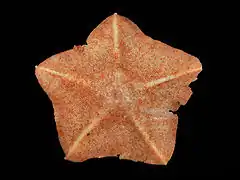 | |
| Anseropoda placenta | |
| Scientific classification | |
| Kingdom: | |
| Phylum: | |
| Class: | |
| Order: | |
| Family: | Asterinidae |
| Genera | |
|
25, see text. | |
Description and characteristics
These are generally small sea stars, flattened dorsally and bearing very short arms, often giving a pentagonal shape in the body (except in some species possessing more than five arms). The periphery of the body is thin and formed by indistinct, tiny marginal plates. They are characterized by their aborale face formed by plates shaped like crescents, sometimes giving a "knitted" appearance to the skin.[2]
The abyssal species can be bigger, like those of the genus Anseropoda, which can exceed 45 cm in diameter.[2]
Biology
Most of the species are small and relatively cryptic: they are often found hidden under rocks or in crevices, for example. Several species have access to a fissiparous asexual reproduction, multiplying their reproductive potential. For that reason, some species of the genera Meridiastra and Aquilonastra can sometimes appear spontaneously in aquariums, where they can proliferate from just one larva imported inadvertently. Some species can brood their young (which thus do not pass through a planctonic larval stage), such as Asterina panceri.[2]
Most of the species feed on food fragments and algal or bacterial mat covering the substratum, evaginating their stomach on their food (a frequent feeding mode in sea stars). However, some species like Stegnaster inflatus takes advantage of their webbed shape to form a "trap" by heightening on the tip of their arms, and suddenly falling on a prey which would have believed to find shelter there.[2]
They can be found in almost all the seas of the world, from the abysses to the surface and from the poles to the tropics.[2]
Genera
This family comprises about 21 genera and 116 species according to O'Loughlin & Waters (2004),[3] whereas the World Asteroidea Database states that it includes 150 species in 25 genera.[1]
Genera included in the family according to the World Asteroidea Database:[1]
- Ailsastra O'Loughlin & Rowe, 2005
- Allopatiria Verrill, 1913
- Anseropoda Nardo, 1834
- Aquilonastra O'Loughlin in O'Loughlin & Waters, 2004
- Asterina Nardo, 1834
- Asterinides Verrill, 1913
- Asterinopsis Verrill, 1913
- Callopatiria Verrill, 1913
- Cryptasterina Dartnall & al. 2003
- Disasterina Perrier, 1875
- Indianastra O'Loughlin in O'Loughlin & Waters, 2004
- Kampylaster Koehler, 1920
- Manasterina H.L. Clark, 1938
- Meridiastra O'Loughlin, 2002
- Nepanthia Gray, 1840
- Paranepanthia Fisher, 1917
- Parvulastra O'Loughlin in O'Loughlin & Waters, 2004
- Patiria Gray, 1840
- Patiriella Verrill, 1913
- Pseudasterina Aziz & Jangoux, 1985
- Pseudonepanthia A.H. Clark, 1916
- Pseudopatiria O'Loughlin in O'Loughlin & Waters, 2004
- Stegnaster Sladen, 1889
- Tegulaster Livingstone, 1933
- Tremaster Verrill, 1880
- Ctenaster L. Agassiz, 1836
- Desmopatiria Verrill, 1913
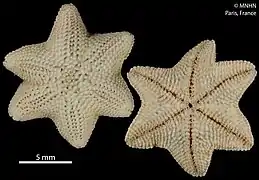 Ailsastra eleaumei (MNHN)
Ailsastra eleaumei (MNHN)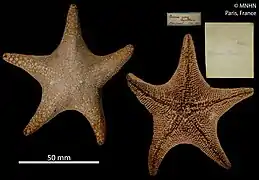 Allopatiria ocellifera (MNHN)
Allopatiria ocellifera (MNHN) Anseropoda placenta
Anseropoda placenta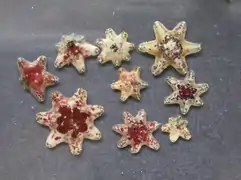
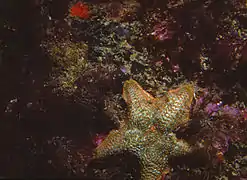
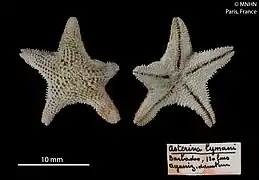 Asterinides pilosa (MNHN)
Asterinides pilosa (MNHN)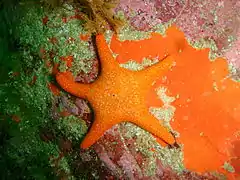
.jpg.webp) Cryptasterina sp.
Cryptasterina sp..jpg.webp) Disasterina abnormalis
Disasterina abnormalis_(cropped).jpg.webp) Indianastra sarasini
Indianastra sarasini_002.jpeg.webp) Kampylaster incurvatus
Kampylaster incurvatus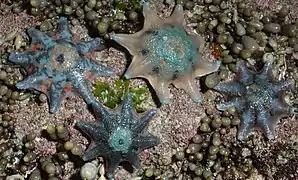
.jpg.webp) Nepanthia maculata
Nepanthia maculata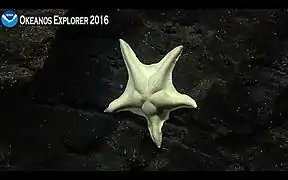 Paranepanthia sp.
Paranepanthia sp.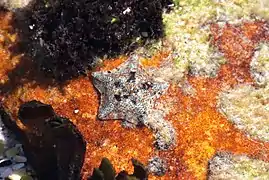
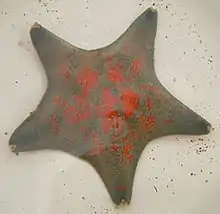
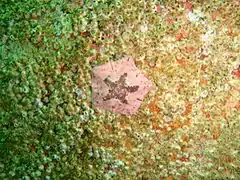 Patiriella dyscrita
Patiriella dyscrita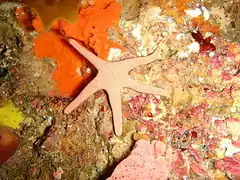 Pseudonepanthia troughtoni
Pseudonepanthia troughtoni.jpg.webp)
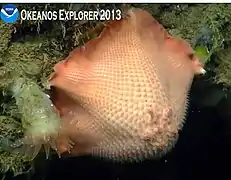 Tremaster mirabilis
Tremaster mirabilis
References
- Mah, Christopher (2013). Mah CL (ed.). "Asterinidae Gray, 1840". World Asteroidea database. World Register of Marine Species. Retrieved 2014-01-19.
- Mah, Christopher L. (June 24, 2015). "Better know The Asterinidae: Familiar & Unfamiliar!". The Echinoblog.
- O'Loughlin, P. M.; Waters, J. M. (2004). "A molecular and morphological revision of genera of Asterinidae (Echinodermata: Asteroidea)" (PDF). Memoirs of Museum Victoria. 61 (1): 1–40.
Bibliography
- P. M. O'Loughlin; J. M. Waters (2004). "A molecular and morphological revision of genera of Asterinidae (Echinodermata: Asteroidea)" (PDF). Memoirs of Museum Victoria. 61 (1): 1–40.
- Byrne, Maria (2006). "Life history diversity and evolution in the Asterinidae" (PDF). Integrative and Comparative Biology. 46: 1–12. doi:10.1093/icb/icj033. PMID 21672739.
External links
- Mah, Christopher L. (June 24, 2015). "Better know The Asterinidae: Familiar & Unfamiliar!". The Echinoblog.
- World Register of Marine Species link: Asterinidae (+species list)
- "Asterinidae". Integrated Taxonomic Information System.